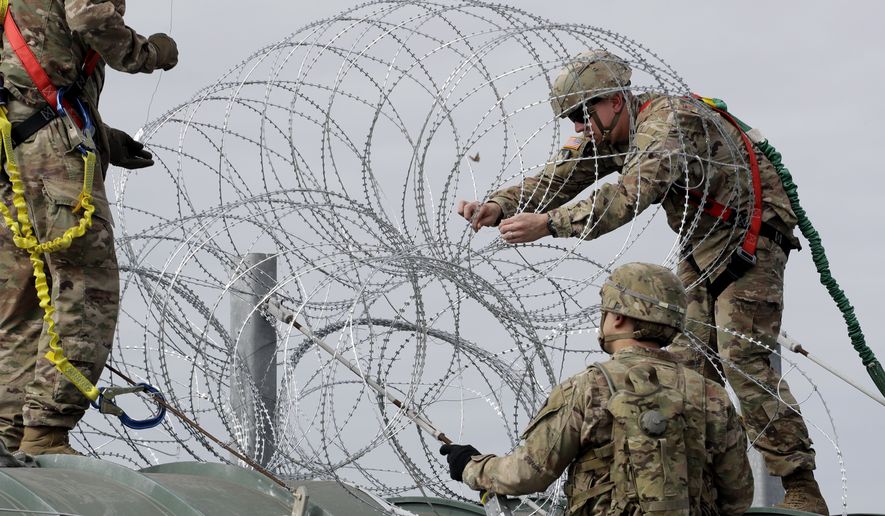President Trump said Sunday that he is considering declaring border security a national emergency and triggering presidential powers that would allow him to assign the military to build his border wall, and he promised a decision based on how shutdown negotiations go.
Some Democrats acknowledged federal law does give Mr. Trump emergency powers, though they signaled they and their allies would try to tie up any such decision in lengthy court battles, in what could be a redux of the travel ban cases.
Mr. Trump raised the possibility at a press conference Friday and repeated it to reporters Sunday afternoon as he returned from Camp David after overseeing a day of shutdown negotiations.
“We’re looking at a national emergency because we have a national emergency,” he said.
The Pentagon last month said it has studied the issue and concluded it does have the legal authority to build border fencing if it is deemed part of a counterdrug operation or part of a national emergency.
Defense officials at the time said while the legal issues had been studied, they did not have specific plans to follow through.
SEE ALSO: Shutdown stretches into third week; no end in sight
Rep. Adam Smith, Washington Democrat and the new chairman of the House Armed Services Committee, said presidents have indeed used emergency construction powers in the past — though he told ABC’s “This Week” program that “primarily it’s been done to build facilities in Afghanistan and Iraq.”
He and Senate Minority Whip Richard J. Durbin, Illinois Democrat, said attempts to use the powers in the U.S. will invite lawsuits over whether there is, in fact, a national emergency.
“He will face a challenge, I’m sure, if he oversteps what the law requires when it comes to his responsibilities as commander in chief,” Mr. Durbin told CBS’s “Face the Nation.”
Those lawsuits could put the courts in the thorny position of refereeing between Mr. Trump’s claims of illegal immigrants, drugs, criminals and terrorists pouring across the southwestern border, and Democrats’ insistence that the borders are secure enough.
“We have a crisis at the border of drugs, of human beings being trafficked all over the world … and criminals and gang members coming through,” the president told reporters Sunday.
Talk about using emergency powers ramped up in the weeks before the shutdown when it appeared the president would sign a stopgap spending bill to keep the government open and would try to find other ways to erect his wall without going to Congress.
SEE ALSO: House Democrats to pass individual spending bills as next government shutdown gambit
But Mr. Trump, under pressure from conservatives eager for a shutdown fight, reversed course and announced that he would reject the spending bill and put the focus back on negotiations.
With the shutdown now in its third week and the negotiations stalemated, the president appears to have renewed his interest — though it’s not clear whether he is serious or whether he views it as a negotiating tactic to try to force action on his marquee 2016 promise.
Congressional Democrats said Mr. Trump would be abusing his powers.
Mr. Smith said the president would be shortchanging the military if he asked it to use its manpower and money to build fencing instead of focusing on missions overseas.
Thousands of troops are already deployed to the border to assist in hardening facilities and providing logistics support — which also irks Democrats.
“Defense spending is for national defense, not the Trump campaign’s political wish list,” said Sen. Jack Reed of Rhode Island, the top Democrat on the Senate Armed Services Committee.
He vowed to rally bipartisan opposition should the president pursue the emergency strategy, and he said Mr. Trump had a Republican-led Congress for two years and should have acted then.
Mr. Trump did win more than $1 billion to build a levee wall and border fencing in the 2018 spending bills. That works out to 84 miles of new and replacement fencing, in addition to dozens of miles funded by the 2017 Homeland Security spending bill.
The fencing being built is based on designs the Border Patrol has been using for years — not the concrete models Mr. Trump envisioned.
Border Patrol agents say the concrete designs proved unfeasible, and agents prefer the steel bollard fencing that has become standard under the Secure Fence Act of 2006.
Mr. Smith voted for that 2006 bill, which mandated 700 miles of two-tier fencing. Mr. Reed voted against it.
On Sunday, Mr. Smith told ABC’s “This Week” program that “the wall is not in itself a bad idea; it’s just, it’s been done.”
He said Mr. Trump hasn’t made the case that new parts of the border need to be fenced beyond the 354 miles that currently have fencing. Another 300 miles have vehicle barriers, but those cannot stop foot traffic.
• Stephen Dinan can be reached at sdinan@washingtontimes.com.
• David Sherfinski can be reached at dsherfinski@washingtontimes.com.




Please read our comment policy before commenting.